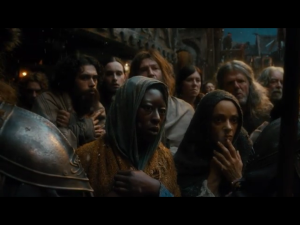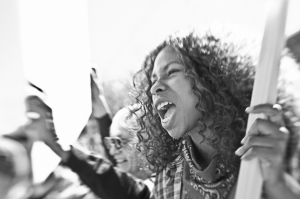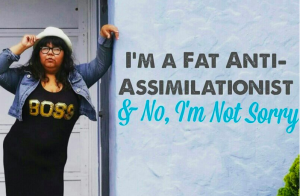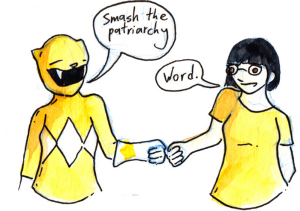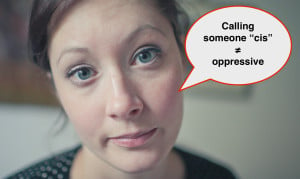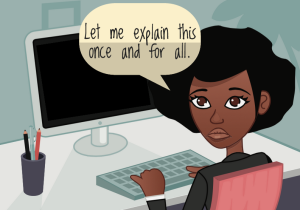
Source: BlogRollCenter
In the quest for better representation of women in the film industry, we have made some significant headway.
Jennifer Siebel Newsom’s The Representation Project, responsible for the must-see documentary Miss Representation, has spearheaded noteworthy anti-misogynistic social media campaigns like #NotBuyingIt and #AskHerMore.
The Hunger Games adaptations, starring Jennifer Lawrence, and Frozen, written and directed by Jennifer Lee, have demonstrated that female protagonists and female writers/directors can translate into box-office bucks. (Progress, no doubt, and note that all three of these Jennifers are white.)
The Bechdel Test — which guarantees not necessarily a great film, but one that has 1) at least two named women who 2) speak to one another about 3) something other than men — has continued to gain popularity, even becoming part of Sweden’s movie rating system.
Nearly a year ago, while watching Peter Jackson’s The Hobbit: The Desolation of Smaug, I was struck by the need for a new test — one targeting racial representation in film.
Fantasy films like Jackson’s trilogies, so often stuck in some incarnation of Medieval Europe, have long poorly represented people of color. As the comedian Wyatt Cenac recently critiqued, such filmmakers can imagine a magic-filled world populated with “dragons and trolls and talking trees,” but they have drawn the line at imagining a dark-skinned hobbit.
Yet, during a scene in the lake town of Esgaroth, I spotted in the crowd two humans of color — neither playing the antagonist, the one role in which people of color have been historically overrepresented.
If you didn’t blink, Middle Earth finally included denizens who couldn’t double as heavy metal rockers.
But was this inclusion evidence of progress? A line of questioning and a new test could help answer this question.
Of course, I’d be remiss not to acknowledge that many people have been asking them for years and years. Black youth, for example, who learn how to behave with police at an early age through the “the talk,” may find these questions blatantly obvious.
But many people, particularly white people, have the luxury not to develop their racial lenses. According to one recent MTV poll, not to mention many others, white people are less likely to grow up in families that discuss issues of race.
So here are some dinnertime questions for the family following your next dose of the supernatural or futuristic:
1. Is the Protagonist White?
Unless the protagonist is played by Will Smith (or perhaps Vin Diesel), the answer is almost certainly yes. This casting choice doesn’t mean the film is racist exactly, but Hollywood’s insistence on white protagonists nevertheless reinforces a racist system.
Keep in mind, children whose imaginations have yet to be repressed by the cruel world will always be drawn to fantasy, sci-fi, and superheroes — genres that include the supernatural without apology. Until Hollywood makes a conscious change, these children will internalize a racist equation: white = hero.
In a speech given before her 2014 Oscar win, Lupita N’yongo, set to star in the continuation of the Star Wars franchise, eloquently testified to the importance of seeing herself reflected in dark-skinned actresses in order to feel beautiful.
Heroism, like beauty, comes in many colors.
2. Is the Antagonist a Person of Color?
As mentioned, ethnocentric Hollywood has a long history of casting people of color as the villain, especially in telling stories of international threats. Fantasy, sci-fi, and superhero films, however, while not confined to our globe, still employ these same patterns – yes, even in galaxies far, far away.
While Lord of the Rings features a flaming vagina as the primary antagonist (also ripe for analysis), you’ll find that the few existing people of color play antagonistic roles, for example, riding the backs of giant elephants in the name of Mordor.
According to some, the Uruk-hai, themselves, recall black people, with their dark skin, broad facial features, and dreadlock-like hair. (In sci-fi, the Klingons are the Uruk-hai of J.J. Abram’s Star Trek universe, featuring these exact same characteristics, down to the dreads.)
Don’t be fooled into thinking that the inclusion of villains of color trumps the exclusion of characters of color. Such inclusion produces another problematic equation: person of color = dangerous and threatening.
When police officers internalize this equation, it can have deadly consequences, particularly for Black people. Of course, no one would argue that these movies directly cause white police officers to kill unarmed Black people. Nevertheless, they contribute to an environment that links darker skin with fear.
However, just like in mathematics, there are exceptions to the rule.
J.J. Abram’s decision to cast Benedict Cumberbatch as Khan in the latest installment of the Star Trek reboot infuriated scores. Ricardo Montalbán, of Mexican descent, originally played the diabolical Khan, becoming perhaps most memorable of Star Trek movie bad guys.
Thus, if the villain of color is a badass of infinite coolness, don’t you dare replace him with a white guy.
3. Are Characters of Color Relegated to a Supporting-Cast Status?
Including characters of color to play a backseat role to the white hero is arguably the most common method of attaining a diverse cast, but it’s arguably just as problematic as casting a white hero or a villain of color.
They all help the audience internalize variations of those same racist equations.
For example, white = the ideal (the hero, the leader, the boss, the one who will ultimately save the day), as well as people of color = less than white people (the servant, the sidekick, the comic relief, the one who may be at times heroic but will never save the day).
Don’t those equations remind us of something? (Cough, cough, slavery.) Racial disparities — from school discipline rates to incarceration rates, from representation in children’s books to the covers of YA literature — exist in virtually all walks of life.
Our voluntarily entertainment choices should not contribute to the list.
4. Are Characteristics Associated with People of Color Hidden, Minimized, or Altered?
I first noticed this technique in the comic books, with the flowing white hair of the X-men’s Storm and the blond wig of The Outsider’s Thunder, both of whom are Black, but without the hair of black women.
Movies may seem diverse when looking at the casting list, but the final products may show us a different story.
 Take Guardians of the Galaxy, the surprise blockbuster of the past summer. Out of the five characters in the ragtag band of outlaws, three are played by actors of color (revealing in itself).
Take Guardians of the Galaxy, the surprise blockbuster of the past summer. Out of the five characters in the ragtag band of outlaws, three are played by actors of color (revealing in itself).
However, not one of these three characters is of color, racially speaking. Vin Diesel’s voice fills a walking, quasi-talking tree, Dave Bautista is painted blue-grey with red tattoos, and Zoe Saldana is painted green.
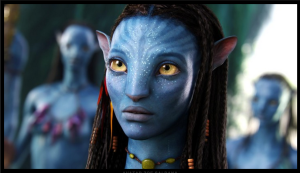 Saldana, also a star of Avatar and the recent Star Trek movies, has definitely broken into the white-dominated worlds of fantasy and sci-fi.
Saldana, also a star of Avatar and the recent Star Trek movies, has definitely broken into the white-dominated worlds of fantasy and sci-fi.
At the same time, of these three hit films, she is only racially herself as Uhuru in Star Trek. As Neytiri in Avatar, Saldana’s skin is again painted, this time blue (a hue similar to Jamie Foxx’s as Electro in Amazing Spider Man 2.)
5. Are You Mad When Traditionally White Characters Are Played by People of Color?
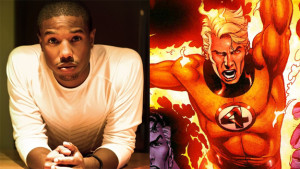 You shouldn’t be.
You shouldn’t be.
As Azie Dungey points out in the Huffington Post, “[Y]ou can’t expect a fiction writer in 1961 to write a black superhero when a black man could not eat at a lunch counter or vote.”
So we should be celebrating that casting choices of Michael B. Jordan as the Fantastic Four’s Human Torch and Jason Momoa as Aquaman, two characters who have always been white males with blond locks.
Similarly, we should have celebrated in 2001 when Dwayne McDuffie chose John Stewart, a black Green Lantern, to become the Green Lantern in the animated Justice League series.
Or in 2011 when Marvel announced that Miles Morales, of black teenager of Puerto Rican descent, would replace Peter Parker as the comic’s Ultimate Spider Man.
Or in 2013 when Marvel announced that Ms. Marvel, originally white and blond, would be reimagined as a Pakistani American, Muslim teenage girl in the comics.
If the film industry is going to follow suit, audiences need to be clamoring for more reimagining until the cast of films reflects the demographics of our diverse country and planet.
Instead, an Asian American male lead in a romantic comedy is so rare that the casting choice becomes a news story. If Bill O’Reilly is right about the prevalence of “Asian privilege” (and he’s not), then Asian Americans should be putting white actors out of work left and right.
John Cho (who plays Star Trek’s Sulu, a role once filled by icon George Takei) and Lucy Liu will both tell you a very different Hollywood story, one based on reality — and racism.
6. Are You Mad When Characters Traditionally Played by People of Color Are Replaced by White People?
You should be.
This practice, known as white washing, also supports a racist system.
We’ve already established that white people disproportionately receive the best, most positive roles. Giving the few roles specifically for people of color to white people only serves to further limit the roles people of color can land, which are already far too limited.
The 2009 documentary Reel Injun documents Hollywood’s history of casting white stars, including Elvis Presley and Burt Reynolds, as Native Americans.
This history continues into the present with Johnny Depp’s portrayal of Tonto and Warner Bros’ recent announcement that Rooney Mara will play Tiger Lily in a remake of Peter Pan.
White washing without a doubt limits the opportunities for actors of color, but it also mangles everyone’s understanding of our world.
When Christian Bale can play Moses and Russell Crow can play Noah in regions filled with brown people, it’s no surprise that so many Americans are insistent on Jesus’s whiteness, despite the wealth of evidence to the contrary.
And this mangling extends to the fantastic worlds as well.
After all, regardless of their settings, these films have something to say about the human condition. Unfortunately, they mostly communicate Hollywood’s acute case of coloritis. (And Hollywood’s justifications can’t just be about money; Dwayne “The Rock” Johnson was the top grossing actor of 2013.)
7. Did You Use the Race Bechdel Test?
Back to those two humans of color in Esgaroth from The Hobbit: The Desolation of Smaug — the two who prompted this whole article.
A test, what I call the Race Bechdel Test, could help us measure racial representation in film. Are there 1) at least two named people of color who 2) who speak to each other about 3) something other than white people?
Alas, despite their welcome presence, these two unnamed, silent residents of color did not help Peter Jackson’s film pass. Maybe it’s a start, but it’s a slow start. The test, however, if more widely implemented, could lead to speedier changes.
Just as the Bechdel Test shows us that men no longer need to be the focal point of every scene — or even the entire movie — the Race Bechdel Test reminds us that neither do white people.
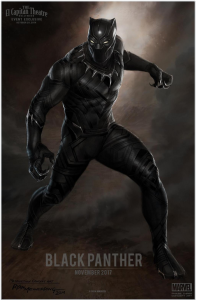 In the wake of DC and Marvel announcing their slate of films to fill the rest of the decade, we need to get this test mainstreamed right away.
In the wake of DC and Marvel announcing their slate of films to fill the rest of the decade, we need to get this test mainstreamed right away.
With the release of Black Panther — whose skin, including the neck and head, has traditionally been covered entirely with costume (a fact that the fourth question illuminates) — we won’t see a big-budget solo superhero film starring a person of color until 2017.
And while we will also have a Wonder Woman movie in 2017, news of a future film featuring a female superhero of color is as likely as a dark-skinned hobbit.
***
This list of questions just scratches the surface of analyzing racial representation in film, but it is a good place to start. Even if you continually find that the answers favor white people, at least you will be tuning your racial lenses to the frequency of injustice.
So what will you do about this injustice?
For one, you can start practicing your eye rolling every time you hear about this country being “post-racial.” A post-racial film industry certainly wouldn’t stubbornly cling to outdated casting habits.
Ultimately, you wield the power of your wallet.
If you don’t want to support a racist system perpetuated by these films, keep your bucks out of the box office. Unfortunately, this choice might cut you off entirely from fantasy, sci-fi, and superheroes movies.
If you’re like me (and have a sort of addiction to seeing the characters of your childhood grace the silver screen), you are likely going to see them anyway.
So what else can you do?
1. Discuss these questions often with your circles of influence. Everybody has people they influence, whether they’re friends, family members, or coworkers. Apply the questions to other arenas, as the issues I raise here are certainly not limited to fantasy, sci-fi, and superhero movies.
2. Expand your film genres and spread your money. Support filmmakers of color and films featuring casts of color.
3. Follow news sources that track racial injustice, including Colorlines, NPR’s Codeswitch, Huffington Post Black Voices, Mic, The Representation Project, and, of course, Everyday Feminism.
4. Initiate or support an online petition demanding more inclusion. This strategy worked well for Julia Bluhm, an eighth grader tired of looking at digitally altered “role models” in the pages of her magazines. Her petition led to Seventeen Magazine’s “No-Photoshop” pledge.
5. Most of all, understand your complicity in these systems, even for something as seemingly benign as purchasing movie tickets.
Fixing such systems will require the efforts of everyone, not just the ones most directly affected.
The status quo is stubborn. So must be those who work to change it.
[do_widget id=”text-101″]
Jon Greenberg is an award-winning public high school teacher in Seattle who has gained broader recognition for standing up for racial dialogue in the classroom — with widespread support from community — while a school district attempted to stifle it. Creator and facilitator of the celebrated curriculum Citizenship and Social Justice, he has dedicated his teaching career to social justice and civic engagement. To learn more about Jon Greenberg and the Race Curriculum Controversy, visit his website, citizenshipandsocialjustice.com. You can also follow him on Facebook and Twitter.
Search our 3000+ articles!
Read our articles about:
Our online racial justice training
Used by hundreds of universities, non-profits, and businesses.
Click to learn more


